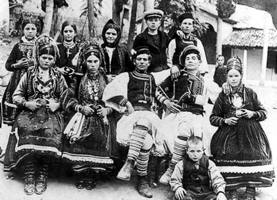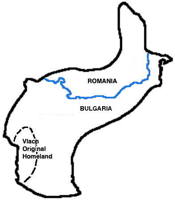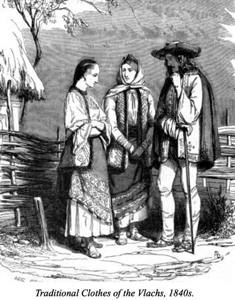
|
The Society of Folk Dance Historians (SFDH) Vlachs
[
Home |
About |
Encyclopedia | CLICK AN IMAGE TO ENLARGE |

|
BACKGROUND
 Information: A culture and a region (Vlachia).
Information: A culture and a region (Vlachia).
Vlachs, also Wallachians (and many other variants), is a historical term from the Middle Ages that designates a name that foreigners use, mostly for the Romanians who lived north and south of the Danube.
As a contemporary term, in the English language, the Vlachs are the Eastern Romance-speaking peoples who live south of the Danube in what are now eastern Serbia, southern Albania, northern Greece, Macedonia, and southwestern Bulgaria as indigenous ethnic groups.
Translation: The name derives from the Aromanians or Vlachs, an ethnic group that lives in several mountainous areas of the Balkans (Vlachia).
Region: Balkan Peninsula in Europe.
Language: Aromanian, a Romance language
THE VLACHS
By Dorothy Archer, 2017

 Some of the nicest music we dance to comes from the Vlachs. The origin of the Vlachs cannot be documented and varies in the telling but they appear to be descendents of the aboriginal people who lived in the province of Dacia in present day Romania. The Romans, who occupied this area from the 2nd century BCE to the 3rd century CE, married with the indigenous people and from here came a new group. They were dispersed due to migrations of other groups after the Romans left and took refuge in mountainous areas of Greece, Albania, and Macedonia. Traditionally they were shepherds and woodworkers although some farmed. Mary Triantafillou, who dances with the Don Heights Group, told us her father was Vlach and came to northern Greece from Yugoslavia when a young man. He referred to himself as Vlachos and his culture as Vlachi. He followed in his father’s footsteps and had a shoe repair business.
Some of the nicest music we dance to comes from the Vlachs. The origin of the Vlachs cannot be documented and varies in the telling but they appear to be descendents of the aboriginal people who lived in the province of Dacia in present day Romania. The Romans, who occupied this area from the 2nd century BCE to the 3rd century CE, married with the indigenous people and from here came a new group. They were dispersed due to migrations of other groups after the Romans left and took refuge in mountainous areas of Greece, Albania, and Macedonia. Traditionally they were shepherds and woodworkers although some farmed. Mary Triantafillou, who dances with the Don Heights Group, told us her father was Vlach and came to northern Greece from Yugoslavia when a young man. He referred to himself as Vlachos and his culture as Vlachi. He followed in his father’s footsteps and had a shoe repair business.
Vlach is a name of Germanic origin adapted by the Slavs which is used generally only in Serbia and Bulgaria. Other groups call themselves Români, Rumâni, Rumâri, Aromâni, and Arumâni. Furthermore, the Aromâni, who live in Greece, use the name of the dialectal group to which they belong. They are not a nationalistic group, therefore, many have disappeared into other cultures but there are still identifiable groups mainly in Romania, Macedonia, central and southern Albania, central and northern Greece, and smaller groups in Croatia, Hungary, Ukraine, and Serbia. There are also Vlach communities in France and Germany and North America.
In the mid-1980s, the Pan-Hellenic Union of Vlach Associations was formed and organizes an annual cultural reunion festival. This Association has also influenced the launch of a monthly newspaper and the publishing of books and CDs. A movie entitled "I’m not Famous but I’m Aromanian" has also been released.
Despite having their own language and traditions, Vlachs are assimilating into the larger Balkan groups. This means that their music and dances are often credited to other communities of the Balkans. Goran Ćirić, who dances with the University of Toronto IFDC group, recognized Homoljanka and other tunes as ones he heard from a Vlach community in Eastern Serbia. While we are all aware that Ini Vitui ni Feata Moi is Aromanian, other dances that just might be Vlach are Lea Musat Armina, Olahos, Vidinsko Horo, and Maica. Researchers in the Pindos Mountains observed Vlach dances in two or more circles, with the women on the outside. They also saw couple dances with partners of the same sex. And, of course, there are the circle dances.
Their songs, while usually danced to, are also sung sitting around a table or a living room. They might use the instruments of their adopted country but their main instrument is their voice. Listening to the singer for Ini Vitui, it is a beautiful instrument.
The preceding article appeared in Folk Dancer Online,
Volume 48 Number 1, February 2017.
Used with permission.
DOCUMENTS
- Aromanian Language, an article.
- Balkans, a region.
This page © 2018 by Ron Houston.
Please do not copy any part of this page without including this copyright notice.
Please do not copy small portions out of context.
Please do not copy large portions without permission from Ron Houston.